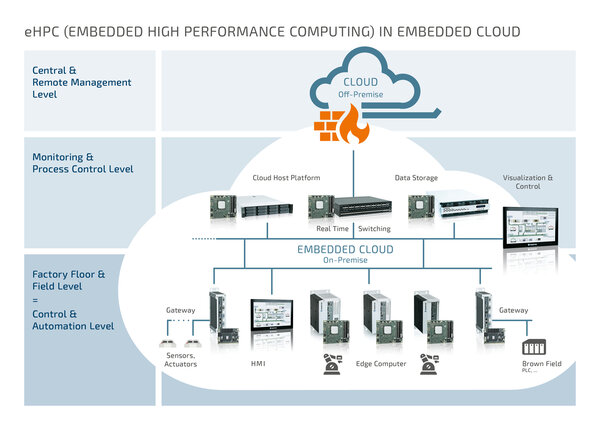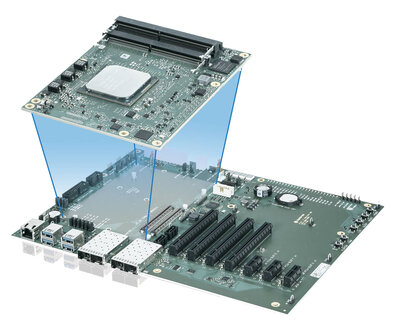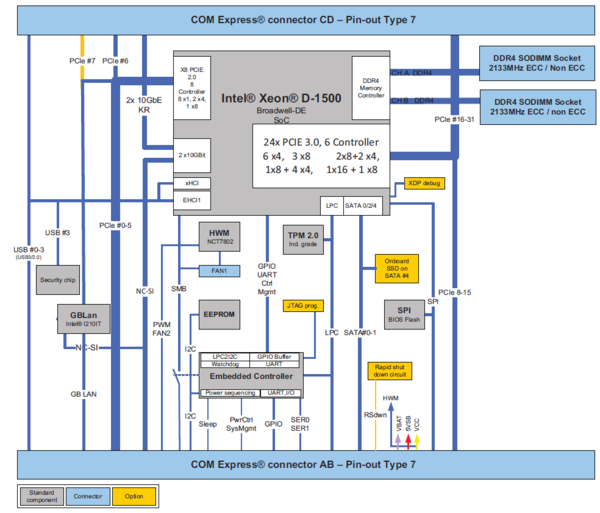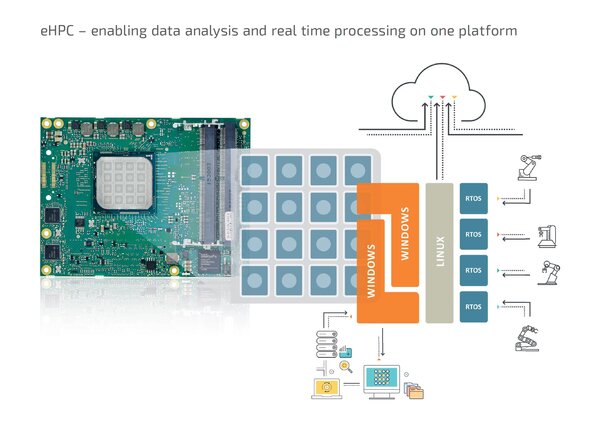eHPC Modules with Outstanding Computing Power
Designed for Industrial Applications from Edge to Cloud

Edge, fog and cloud applications demand strongly increasing computing power. Traditional server approaches cannot provide the required robustness for operation in harsh industrial environments. Modular systems based on the well-established and tested COM Express modules provide an effi cient solution. Type 7 is a new variant, which first time ever satisfies the demands for embedded high performance computing (eHPC).
In contrast to most business and IT applications, many production tasks cannot be easily outsourced to a cloud, although it would be useful by means of simplification, cost savings, and maintenance. In spite of modern infrastructures such as TSN-based networks, the physical length of the lines with the associated latencies often sets an abrupt end to the desire for real-time control out of the cloud. Also, many companies do not want to see their entire production data and know-how to be stored and processed outside the companies’ premises. The proven solution to this challenge are approaches like edge and fog computing. In practice, this means to move the cloud physically closer to production and / or consolidate data by on-site pre-processing. Of course, there are robust, industry-grade edge gateways available however their performance is limited. In many scenarios, it is most cost-efficient and service-friendly to maintain ample computing power directly on site. A key enabler for cost-efficiency can be wide scalability- highest availability and reliability are generally required in industrial applications any way. Features, which have been long known and appreciated with standardized computer modules (COMs). So what would be closer than to build up an own, scalable computing infrastructure based on proven module systems? This way it could be designed to fit today’s demands right now with the option to be upgraded later.
Which module from which manufacturer?
One of the main advantages of the use of COMs is the largely pre-integrated platform. The customer can fully concentrate on the development of his own (application) software. This is where the know-how for the respective solution and also the actual core competency and the added value of his company is based. Ideally, the module supplier offers a carrier board, which already contains all required interfaces. If, however, special functions (in the industrial field, these are usually special fieldbus interfaces) are missing, it saves a lot of time and headaches if the corresponding know-how of the module supplier can be accessed. So the system integrator can access existing solutions (IP) and / or resources of the module manufacturer easily. Additional resources can be saved and the development time can be further shortened. This applies in particular to elements which require specific knowledge and experience, such as all aspects of safety (safety and security). It is particularly important here that the module manufacturer uses components and technologies that have already proved their worth. Ideal are standardized, cross-platform concepts that also lead to time and cost-saving synergy effects with regard to know-how and quality.

A perfect manufacturer should be able to proof not only many years of experience in the production of standardized modules, but also reference a broad range of customers and experience based on the specific application. The widest scalability with regard to maximum power dissipation (and thus indirectly also maximum computing power) is currently under the established embedded module standards comes with the PICMG’s COM Express standard. For instance, its “Basic” size form factor with the compact dimensions of only
95 x 125 mm² can use processors with a TDP (thermal design power) of 50 watts and more without problems. The rapidly growing demand for high computation and network performance in the modular and embedded market has also led to the PICMG having redefined an ideal standard for exactly this task when it came to the last revision of the COM Express standard. This was derived from the COM Express Standard Type 6, which is dominating the current embedded market. With the partial reorganization of the signals on the connectors, graphic signals were dropped and replaced by four 10GBit interfaces to support requirements for more and faster external Ethernet connections. In addition, eight additional PCI Express® lanes were added to achieve higher throughput. A further advantage of the design concept of COM Express is that the modules can be used not only as mezzanines (plug-in boards) for a more or less complex carrier board, but also as a complete single-board computer (SBC). This makes building multi-module systems particularly easy. Depending on the thermal design, up to nine Type 7 modules in the “Basic” size and thus up to 144 CPU cores can be accommodated in a single 19” plug-in unit.
A perfect fit: Kontron’s COM Express Type 7 Modules
Pioneering the evolution of standard COMs and as a long-standing member of the PICMG, Kontron has performed an important role with the creation of the new Type 7 standard. They are not just offering COMs and standardized carrier boards but also customer-specific carrier board development.
The long-term know-how as a market leader in embedded systems of various standards enables superior product quality with Hard- and Software and a great value pricing taking benefit of the associated synergy effects. Key features such as the APPROTECT security framework or the seamlessly integrated and IPMI-compliant, optional BMC (Baseboard Management Controller) are available for many Kontron platforms, while simplifying operation and maintenance for the customers.
This allows a wide scaling and application transparency even beyond the module and embedded area. Upgrades can be made by simple module exchange, and complex fieldbus and sensor interfaces as well as special machine adaptions on the baseboard can be maintained over several CPU generations.

Typ 7 module with carrier board
While the COM Express standard is designed for operation in harsh industrial operation by default, Kontron’s long-term experience with particularly hard-wearing (“rugged”) computer hardware puts a significant benefit on top. The high level of vertical integration including inhouse production facilities within the S&T group supports the longevity and durability of the Kontron embedded products, too.
An additional advantage for all types of cloud and cloud-oriented applications is the scalability to the new Kontron embedded servers and the long-standing cloud and IT experience of the parent company S & T. No competitor can currently offer such widely scalable and comprehensive solutions.
The Kontron COME-bBD7 eHPC modules can be equipped with many popular CPUs of the current Intel® Xeon® Processor D-1500 family with 2 to 16 CPU cores, 25 to 45 watts TDP and up to 2.2 GHz clock frequency as well as variants for the extended temperature range of -40 °C to 85 °C. The two DDR4 SODIMM slots are dual-channel and ECC-capable and can be equipped with up to 32 GByte. In addition to the usual embedded features such as SPI, LPC, SMB, Fast I²C, RTC and staged watchdog, 2 serial interfaces, 4x USB 3.0 / 2.0 and 2 SATA3 interfaces with 6 Gb/s are standard on the module. Both the two on-chip 10GbE connectors as well as the Intel I210IT 10/100/1000 Mbit Ethernet controller can be connected to an external BMC present on the baseboard via NC-SI (Network Connect Sideband Interface). This BMC allows monitoring of the COMe-bBD7 module and supports remote management as well as preemptive maintenance measures. The COMe Evaluation Carrier T7 Board has been newly developed especially for the Kontron COMe-bBD7. It comes with an ATX form factor (305 x 244 mm²) and forms a turnkey server development platform together with the module. It supports e.g. 4x 10GbE,
32 PCIe lanes, 4x USB3.0, 2x SATA3, 2x RS232, GPIO, optional IPMI 2.0 compatible BMC (board management controller) with KVM support via adapter card. Kontron provides the full design documentation of the evaluation carrier for fast baseboard development.

Block diagram Kontron COMe-bBD7
In addition, Kontron offers optional design-in support by experienced engineers. This enables a significant further shortening of development times. If necessary, the eHPC module itself can be modified, too, in order to optimal adaption to specific customer requirements. As a long-term market and technology leader, Kontron has both the know-how and the capacities for its design services.
Security matters!
Each COMe-bBD7 module by default features Kontron APPROTECT, a comprehensive, cross-platform security which consists of hardware and software components and can be activated after purchase in order to protect your own software investment. It contains modules for copy protection, IP protection (licensing), protection against reverse engineering and tampering. This allows comprehensive license management and completely new licensing and business models, such as billing according to usage time and test periods for certain features. It also can be retrofitted for legacy systems. The integrated Trusted Platform Module (TPM) 2.0 chip ensures the highest security level.
APPROTECT today has the broadest scalability of all integrated security solutions in the market. The support ranges from poorly resourced nano systems with single core up to big multicore server modules - everything is available from a single source! Kontron’s turnkey solution enables highest security for customer data and programs with least implementation effort.

What about the future?
Big Data is the trend of the future and more and more data must be reliably recorded and processed physically close to machine and cloud. Interfaces to sensors and actuators are largely stable technology and only the requirements for computing power grow disproportionately. So embedded solutions with interchangeable computer modules (COMs) offer an unbeatable price/performance ratio and guaranteed future. The robust design allows safe use within an immediate production environment. The possibility of outsourcing control functionality to real-time embedded high-performance computers (eHPC) and their physical proximity to the production equipment lead to further cost savings through consolidation without sacrificing safety or functionality.
Trust the market leader:
Kontron is world market leader when it comes to integrated embedded server systems.
The market leadership is further expanded by new synergetic corporate structures and fresh money. The friendly merger with S&T strengthens Kontron’s market position even more as the share of software in today’s industrial solutions is becoming ever more important.
Kontron offers complete, scalable solutions from a single source, which results in a long term secure investment.
Download this Article
-----------------------------------------------------------------------------------------------------------
German Article:
eHPC-Module mit höchster Rechenleistung
Für industrielle Anwendungen von Edge bis Cloud
Edge-, Fog- und Cloud-Anwendungen verlangen immer höhere Rechenleistung. Klassische Serverlösungenbieten hier aber meist nicht die benötigte Rbustheid für den Betrieb im raueb industriellen Umfeld. Eine bewährte Lösung sind modulare Systeme basierend auf den bewährten COM Express Modulen. Mit Typ 7 steht hier erstmals eine Variante zur Verfügung, die sich von der Leistung her für Embedded High Performance Computing (EHPC) eignet.
Im Gegensatz zu den meisten kaufmännischen und IT-Anwendungen lassen sich viele Aufgaben in der Produktion nicht einfach in eine Cloud auslagern, obwohl dies unter den Aspekten von Vereinfachung, Kostenersparnis und Wartung durchaus sinnvoll wäre. Denn trotz moderner Infrastrukturen wie etwa TSN-basierenden Netzen setzt oft schon allein die physikalische Leitungslänge mit den einhergehenden Laufzeiten (Latenzen) dem Wunsch nach einer Echtzeitsteuerung aus der Cloud ein jähes Ende. Auch will nicht jede Firma ihre kompletten Produktionsdaten und damit -geheimnisse außerhalb des Firmencampus gespeichert und verarbeitet sehen. Die Lösung liegt bei Ansätzen wie Edge- und Fog-Computing darin, die Cloud näher an die Produktion zu bringen und/oder eine konsolidierende Vorverarbeitung vor Ort durchzuführen (Bild 1). Dazu gibt es bereits heute robuste, industrietaugliche Edge-Gateways, deren Leistungsfähigkeit aber beschränkt ist. Kosten- und wartungsgünstiger ist es in den meisten Fällen, gleich mehr Rechenleistung unmittelbar vor Ort vorzuhalten. Eine Schlüsselrolle für die Kosteneffizienz spielt hier die Skalierbarkeit; höchste Verfügbarkeit und Zuverlässigkeit werden bei industriellen Anwendungen grundsätzlich vorausgesetzt. Eigenschaften, wie man sie schon lange bei standardisierten Computermodulen (COMs) kennt und schätzt. Was liegt also näher, als sich seine eigene, skalierbare, jetzt passende und später aufrüstbare Computing-Infrastruktur auf Basis von bewährten Modulsystemen hinzustellen?
Welches Modul von welchem Hersteller?
Einer der Hauptvorteile des Einsatzes von COMs liegt in der weitgehend vorintegrierten Plattform. Der Kunde kann sich voll auf die Entwicklung der eigenen (Anwendungs-) Software konzentrieren, in der das Know-how für die jeweilige Lösung und auch die eigentliche Kernkompetenz und die Wertschöpfung steckt. Im Idealfall bietet der Modullieferant ein Carrier-Board an, das bereits alle benötigten Schnittstellen enthält. Fehlen aber besondere Funktionen (im industriellen Bereich sind dies meist spezielle Feldbus-Interfaces), so ist es hilfreich und spart viel Zeit, wenn auf entsprechendes Know-how des Modullieferanten zugegriffen werden kann. Kann der Systemintegrator hier auf bestehende Lösungen (IP) und/oder Ressourcen des Modulherstellers zugreifen, so können hier weitere Eigenressourcen eingespart und die Entwicklungszeit weiter verkürzt werden. Dies betrifft insbesondere Elemente, die spezifische Kenntnisse und Erfahrungswerte voraussetzen wie etwa alle Aspekte der Sicherheit (Safety und Security). Gerade hier ist es wichtig, dass der Modulhersteller Komponenten und Technologien einsetzt, die sich bereits bewährt haben. Ideal sind hier standardisierte, plattformübergreifende Konzepte, die zu Zeit- und Kosten sparenden Synergieeffekten bei Know-how und Qualität führen.

Ideal ist also ein Hersteller, der nicht nur langjährige Erfahrung in der Fertigung von normierten Modulen hat, sondern auch eine möglichst breite Kunden- und Erfahrungsbasis rund um die eigene Anwendung. Die weiteste Skalierbarkeit bezüglich maximaler Verlustleistung (und damit indirekt auch maximaler Rechenleistung) besitzt unter den etablierten embedded Modulstandards derzeit der COM Express Standard der PICMG. Hier können z.B. im Formfaktor Basic mit den kompakten Abmessungen von nur 95 x 125 mm² problemlos Prozessoren mit einer TDP (Thermal Design Power) von 50 Watt und mehr eingesetzt werden. Der stark anwachsende Bedarf für hohe Rechen- und Netzwerkleistung auch im modularen und embedded Markt hat dazu geführt, dass die PICMG bei ihrer letzten Überarbeitung des COM Express Standards mit dem Typ 7 einen idealen Standard für genau diese Aufgabenstellung neu festgelegt hat. Dieser wurde aus dem ebenso bewährten wie im aktuellen embedded Markt dominierenden COM Express Standard Typ 6 abgeleitet. Bei der teilweisen Neuorganisation der Signale auf den Steckverbindern wurde auf Grafik-Signale verzichtet und stattdessen bis zu vier 10GBit Interfaces nach außen unterstützt um den Anforderungen nach schnelleren Ethernet-Verbindungen Rechnung zu tragen. Zudem wurden acht weitere PCI Express® Lanes hinzugefügt um einen höheren Durchsatz erzielen zu können. Ein weiterer Vorteil des Design-Konzeptes von COM Express ist es, dass die Module nicht nur als Mezzanine (Aufsteck-Boards) für ein mehr oder weniger komplexes Trägerboard eingesetzt werden können, sondern bei entsprechender Infrastruktur auch als vollwertiger Single-Board-Computer (SBC). Dies macht den Aufbau von Mehrmodul-Systemen besonders einfach. So können beispielsweise in einem 19“ Einschubgehäuse je nach thermischer Auslegung bis zu neun Typ 7-Module in der Größe „Basic“ und damit bis zu 144 CPU-Kerne untergebracht werden.
Die Lösung:
COM Express Module Typ 7 von Kontron
Kontron hat als Pionier der Standard COMs und langjähriges Mitglied der PICMG den Typ 7 Standard mit auf den Weg gebracht und bietet hier sowohl COMs wie auch Standard Carrier Boards wie auch kundenspezifische Carrier-Board Entwicklung an. Das langjährige Know-how als Marktführer bei embedded Systemen verschiedenster Standards führen dabei über die verbundenen Synergieeffekte nicht nur zu günstigen Preisen, sondern vor allem auch zu überragender Produktqualität bei Hard- und Software. Wesentliche Alleinstellungsmerkmale wie etwa das Sicherheits-Framework APPROTECT oder der nahtlos integrierte und IPMI-fähige optionale BMC (Baseboard Management Controller) sind für viele Kontron-Plattformen verfügbar und ver-einfachen so Bedienung und Wartung.
Dies ermöglicht eine weite Skalierung und An-wendungstransparenz auch über den Modul- und embedded-Bereich hinaus. Upgrades können durch einfachen Modultausch erfolgen und aufwändige Feldbus- und Sensorinterfaces sowie spezielle Maschinenadaptionen auf dem Baseboard können so über mehrere CPU-Generationen beibehalten werden.

Typ 7 Modul mit Carrier Board
Der COM Express Standard an sich ist schon auf den Betrieb im rauen industriellen Betrieb ausgelegt. Die langjährige Erfahrung mit besonders widerstandsfähiger („rugged“) Computerhardware, die hohe Fertigungstiefe und die Produktionsstätten im eigenen Konzern wirken sich zusätzlich positiv auf Haltbarkeit und Lebensdauer der Kontron embedded Produkte aus. Zusätzlicher Vorteil für alle Arten von Cloud- und Cloudnahen Anwendungen sind die Skalierbarkeit zu den neuen Kontron Embedded Servern und die langjährige Cloud- und IT-Erfahrung des Mutterkonzerns S&T. Kein Mitbewerber kann aktuell dermaßen weit skalierbare und dermaßen komplette Lösungen anbieten.
Die Kontron eHPC-Module vom Typ COMe-bBD7 können mit vielen gängigen CPUs der aktuellen Intel® Xeon® Processor D-1500 Familie mit 2 bis 16 CPU-Kernen und von 25 bis 45 Watt TDP und bis zu 2,2 GHz Taktfrequenz sowie Varianten für den erweiterten Temperaturbereich von -40 °C bis 85 °C bestückt werden. Die beiden DDR4 SODIMM-Plätze sind Dual Channel und ECC-fähig und können mit bis zu 32 GByte bestückt werden. Neben den üblichen embedded-Features wie SPI, LPC, SMB, Fast I²C, RTC und staged Watchdog sind auch 2 serielle Interfaces, 4x USB 3.0/2.0 und 2 SATA3 Interfaces mit 6Gb/s standardmäßig auf dem Modul vorhanden. Sowohl die beiden on-Chip vorhandenen 10GbE Anschlüsse wie auch der Intel I210IT 10/100/1000 Mbit Ethernet Controller können über NC-SI (Network Connect Sideband Interface) an einen externen auf dem Baseboard vorhandenen BMC angeschlossen werden. Dieser BMC erlaubt eine Überwachung des COMe-bBD7 Moduls und unterstützt damit Remote-Management sowie Preemptive Maintenance Maßnahmen.
Das speziell für das Kontron COMe-bBD7 neu entwickelte COMe Evaluation Carrier T7 Board im ATX-Formfaktor (305 x 244 mm²) bildet zusammen mit dem Modul eine schlüsselfertige Server Entwicklungs-Plattform (Bild 2). Es unterstützt u.a. 4x 10GbE, 32 PCIe Lanes, 4x USB3.0,
2x SATA3, 2x RS232, GPIO und optional per Adapter Card einen IPMI 2.0 kompatiblen BMC (Board Management Controller) mit KVM-Unterstützung. Kontron stellt zur schnellen Baseboard-Entwicklung Design-Unterlagen des Evaluation-Carriers zur Verfügung.

Block Diagramm Kontron COMe-bBD7
Darüber hinaus bietet Kontron optional Design-in Unterstützung durch erfahrene Ingenieure an. So kann die Entwicklungszeit nochmals weiter verkürzt werden. Bei Bedarf kann auch das eHPC-Modul selbst modifiziert werden, um dieses optimal an spezielle Kundenanforderungen anpassen zu können. Als langjähriger Markt- und Technologieführer verfügt Kontron mit seinen Design Services sowohl über das Know-how wie auch die Kapazitäten hierfür.
Jederzeit Sicherheit!
Das COMe-bBD7 Modul verfügt serienmäßig über ein umfassendes, plattformübergreifendes Sicherheits-Framework - Kontron APPROTECT, das aus Hardware und Software Komponenten besteht und nach dem Kauf aktiviert werden kann, um eigene Software zu schützen. Es enthält Module für Kopierschutz, IP-Schutz (Lizensierung), Schutz gegen Reverse Engineering und Manipulationen (Tampering). Dies ermöglicht umfangreiches Lizenzmanagement und völlig neue Lizensierungs- und Geschäftsmodelle wie etwa Abrechnungen nach Benutzungszeit, Testphasen für bestimmte Features, und ist auch für Altsysteme nachrüstbar. Der integrierte Trusted Platform Module (TPM) 2.0 Chip sorgt hierbei für höchste Sicherheit.
APPROTECT verfügt heute über die weiteste Skalierbarkeit aller integrierten Sicherheitslösungen im Markt. Die Unterstützung reicht dabei vom ressourcenarmen Nanosystem mit Einzelkern bis hin zu Multicore-Servermodulen – es ist alles aus einer Hand verfügbar! Mit der schlüsselfertigen Lösung von Kontron erhalten Sie mit geringem Aufwand höchste Sicherheit für ihre Daten und Programme!
Was bringt die Zukunft?
Der Trend geht eindeutig zu Big Data, wobei immer mehr Daten zuverlässig erfasst und maschinen- und cloudnah verarbeitet werden müssen. Da die Interfaces zu Sensoren und Aktoren weitgehend stabil sind und nur die Anforderungen an Rechenleistung überproportional wachsen, bieten embedded Lösungen mit austausch-baren Computermodulen (COMs) ein unschlagbares Preis-/Leistungsverhältnis und Zukunftssicherheit. Der robuste Aufbau ermöglicht den sicheren Einsatz im unmittelbaren Produktionsumfeld. Die durch die unmittelbare Nähe mögliche Auslagerung von Steuerfunktionalität auf echtzeitfähige embedded High Performance Computer (eHPC) führt zu weiterer Kostenersparnis durch Konsolidierung (Bild 4), ohne dabei Einbußen an Sicherheit oder Funktionalität in Kauf nehmen zu müssen.

Vertrauen Sie dem Marktführer:
Kontron ist Weltmarktführer, wenn es um integrierte embedded Server Systeme geht.
Die Marktführerschaft wird durch die neue Konzernmutter mit frischem Kapital weiter ausgebaut. Die Verbindung mit S&T macht Kontron noch zukunftssicherer, da bei den heutigen Industrielösungen der Anteil an Software immer bedeutender wird.
Kontron bietet vollständige, beliebig skalierbare Lösungen aus einer Hand was für den Kunden in der Praxis ein langfristig sicheres Investment bedeutet.
